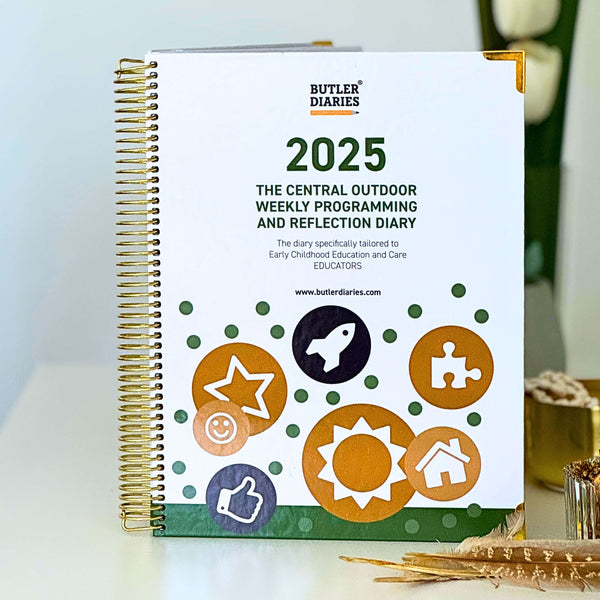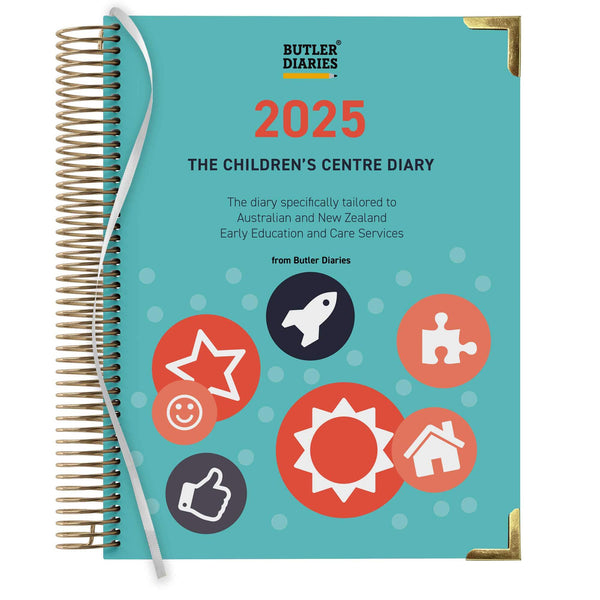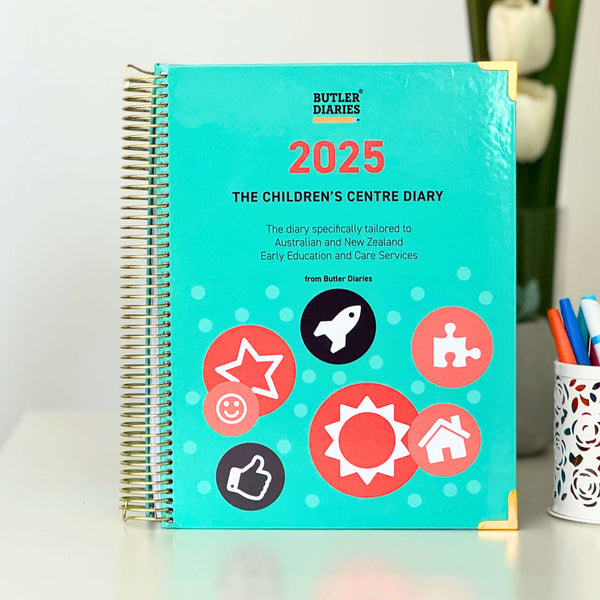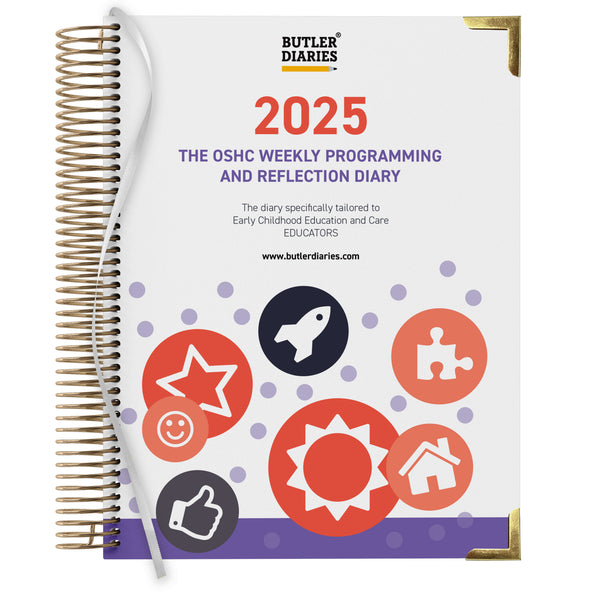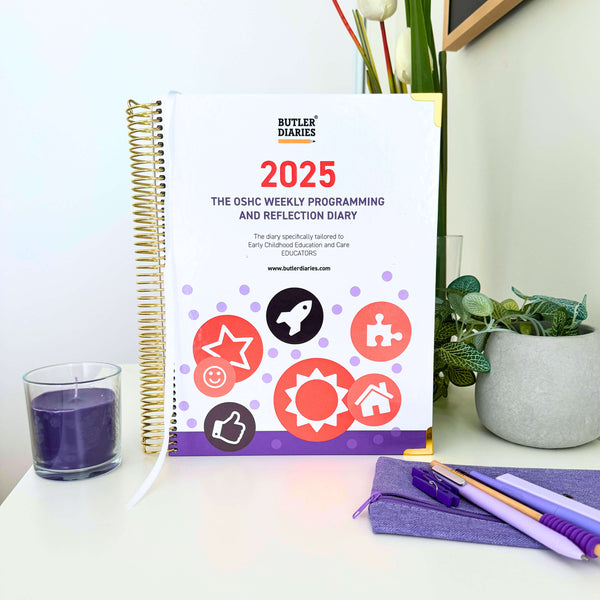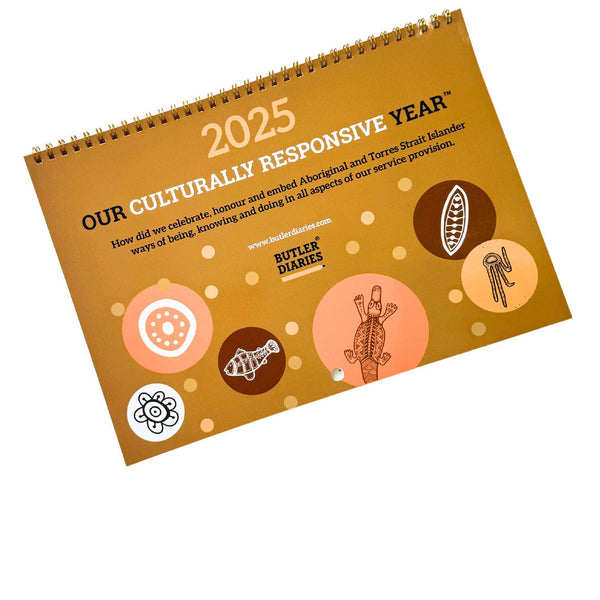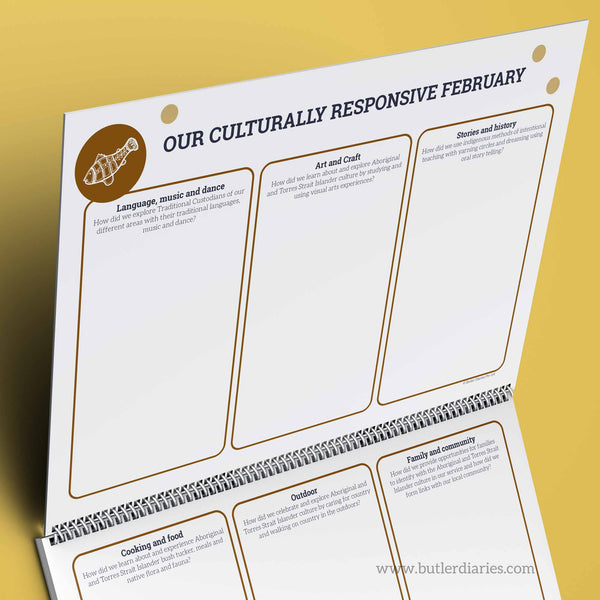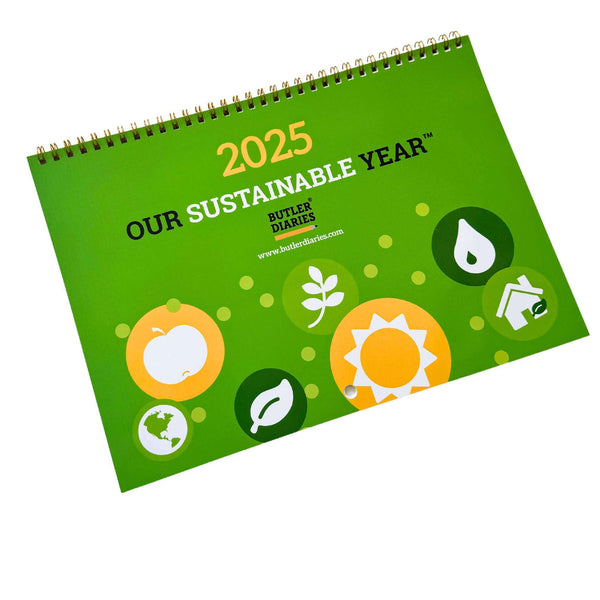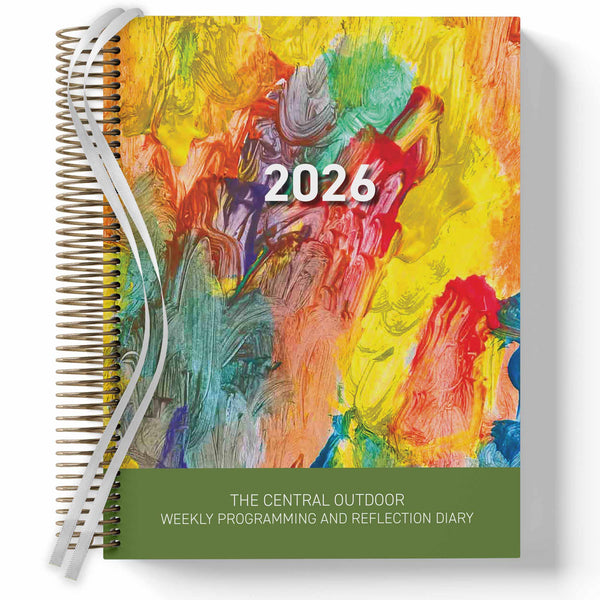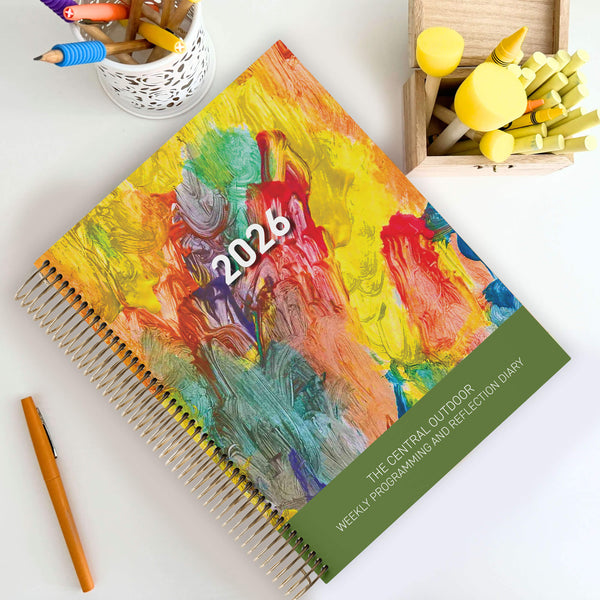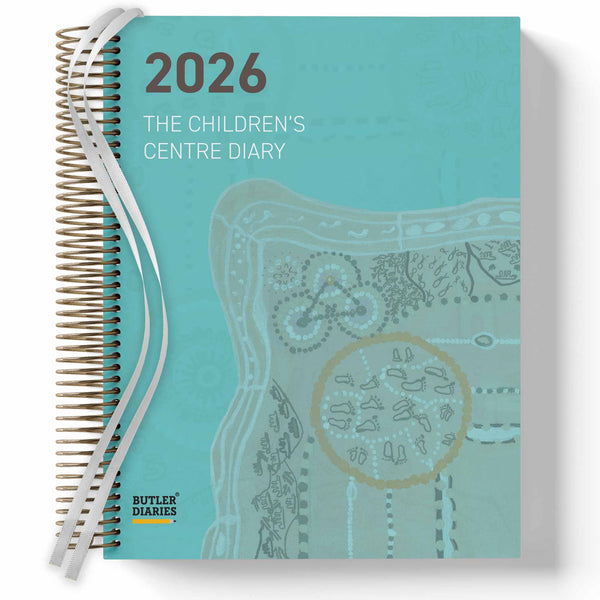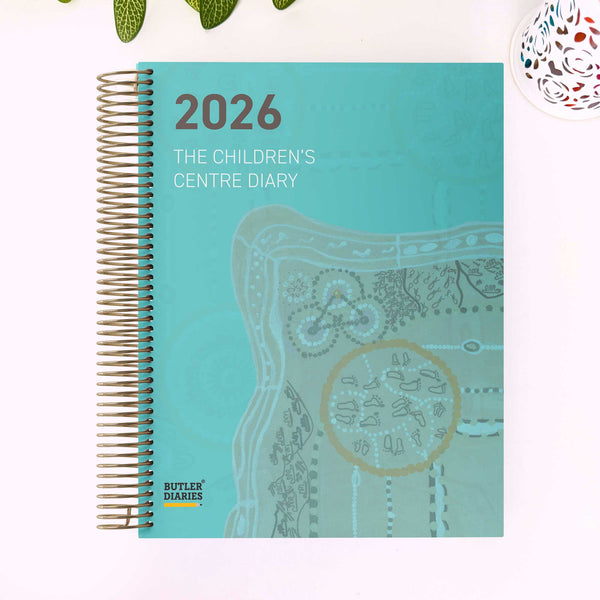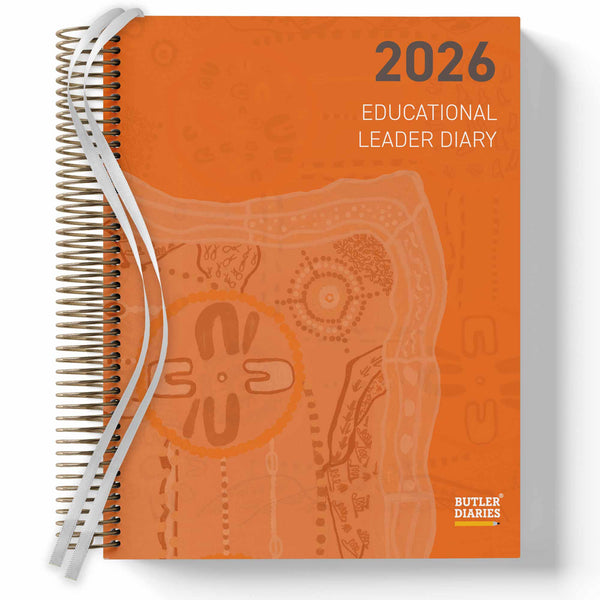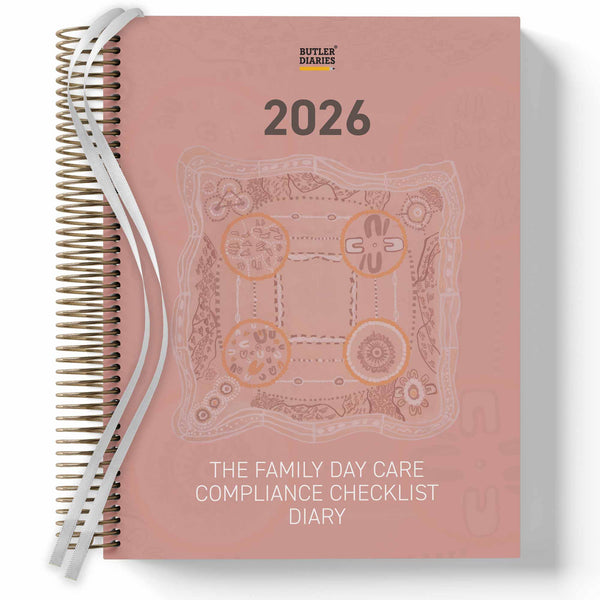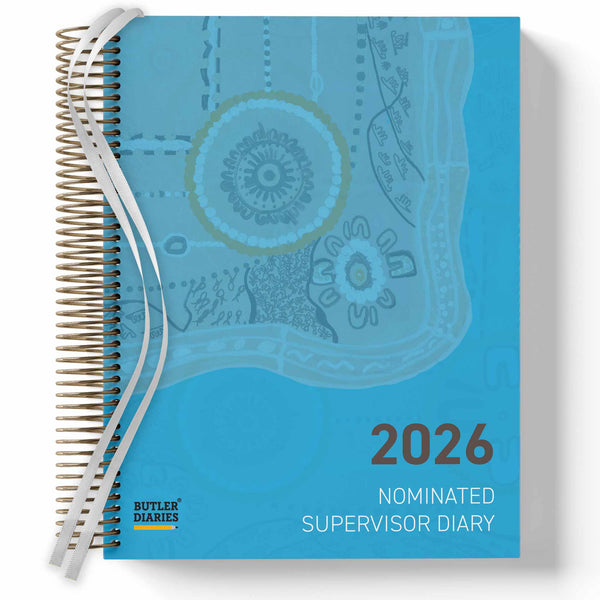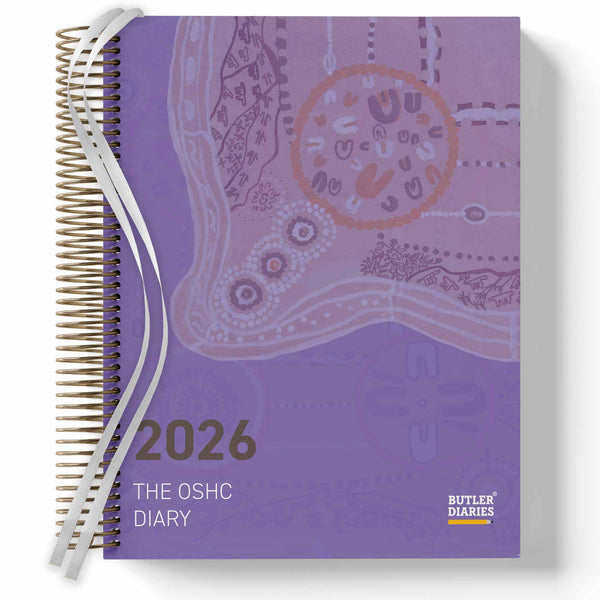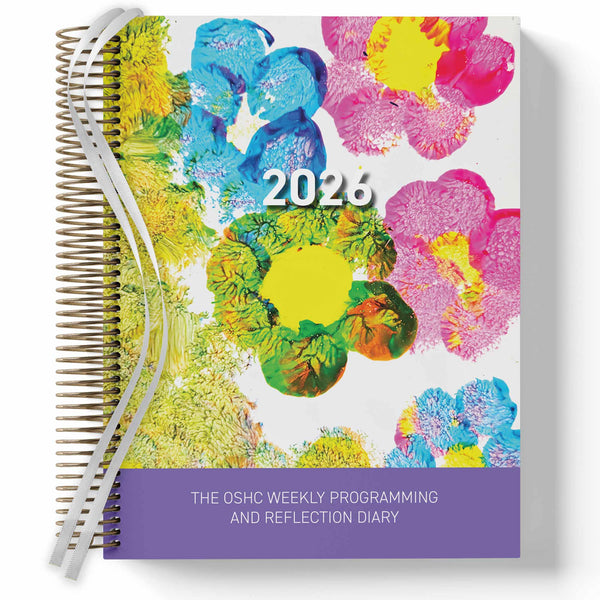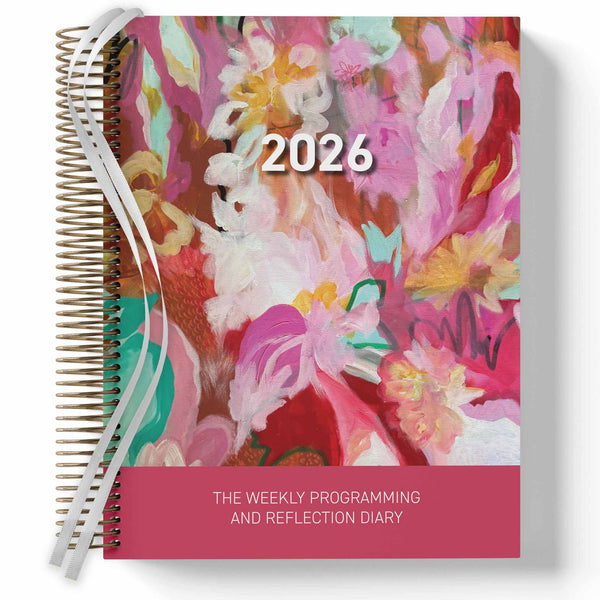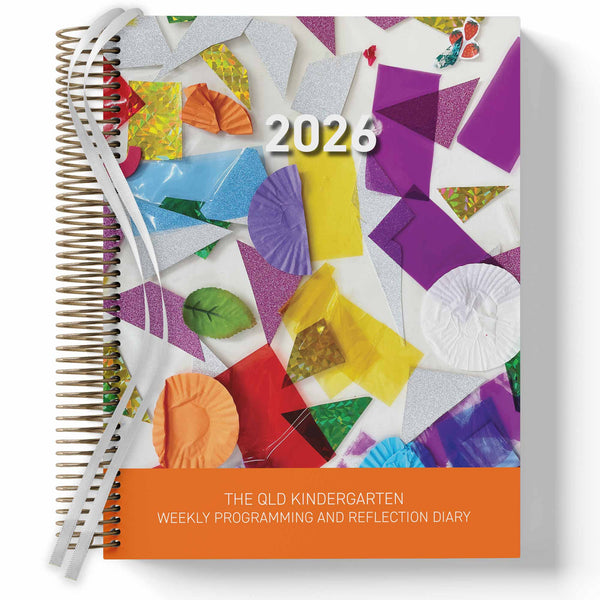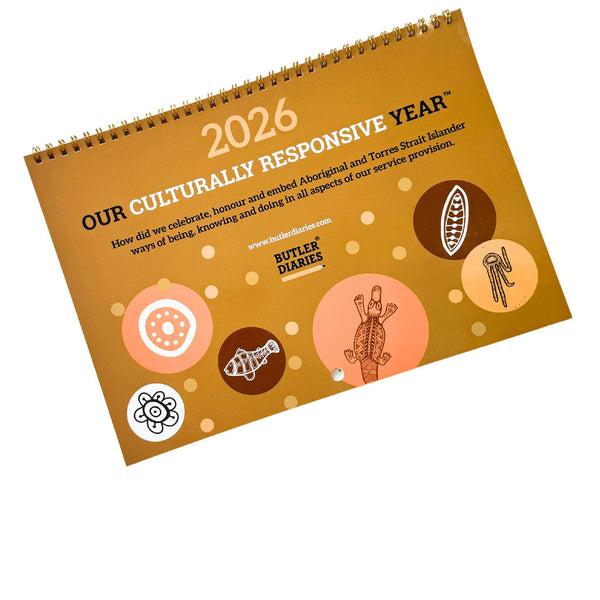Time management is a constant challenge for early childhood educators in Australia. Balancing direct care, administrative tasks, and compliance with the National Quality Framework (NQF) can feel overwhelming. Studies show educators spend 62% of their day with children, while 26% is taken up by admin work, often spilling into unpaid hours. This imbalance not only affects productivity but contributes to emotional burnout, with 60% of educators planning to leave the sector within three years.
To tackle these challenges, practical strategies include:
- Scheduling tools: Use planners like the Weekly Programming and Reflection Diary ($69.99) with digital templates and resources ($9.99) to organise tasks.
- Task prioritisation: Apply methods like the Eisenhower Matrix or SMART goals to focus on what matters most.
- Time-blocking: Allocate specific time slots for focused work, reducing multitasking stress.
- Digital tools: AI-powered platforms can cut documentation time by up to 80%. Here are some tips on using chatGPT with your program.
- Streamlined compliance: Tools like Butler Diaries ($69.99) simplify regulatory tracking and daily planning.
Time Management Problems Educators Face
Early childhood educators in Australia grapple with a host of time management challenges. Balancing meaningful interactions with children while handling administrative duties and meeting strict regulatory standards can stretch their schedules to the limit. To navigate these demands, effective planning and scheduling tools are essential.
Managing Admin Work and Teaching Tasks
One of the toughest challenges educators face is juggling their time between engaging with children and handling administrative responsibilities. On average, educators spend 62% of their day directly interacting with children, leaving the remainder for administrative tasks and personal time. Activities like planning, documentation, and general admin work eat up a significant portion of their day, making it difficult to strike a balance.
This constant switching between child-focused care and paperwork requires a great deal of mental energy. As a result, many educators find themselves working beyond their contracted hours to keep up with the growing administrative workload. This imbalance not only adds stress but also diminishes the time they can dedicate to the children in their care.

Meeting Deadlines While Maintaining Care Standards
Educators are under immense pressure to meet deadlines while ensuring the quality of care remains high. With new research, methodologies, and regulations regularly introduced, the workload continues to grow. On any given day, educators must cater to individual children's needs, manage behaviours, communicate with parents, and stay up to date with industry changes - all while meeting compliance deadlines.
Financial constraints make this situation even more challenging. The average early learning teacher earns $30,210 annually, and early childhood educators face a poverty rate that is eight times higher than that of K-8 teachers. Many simply cannot afford to dedicate additional unpaid hours to manage their responsibilities. This unsustainable workload has led to a high turnover rate, with 60% of educators planning to leave the sector within three years. Nearly all early learning centres (97%) have reported staff departures in the past year alone.
Working Within Regulatory and Local Requirements
Australia’s regulatory environment adds another layer of complexity to educators’ time management struggles. The National Quality Framework (NQF), overseen by the Australian Children's Education & Care Quality Authority (ACECQA), places significant demands on educators.
More than two-thirds of early childhood educators report working extra hours to meet regulatory requirements, and during accreditation periods, half of them work unpaid overtime. These periods often result in less time spent with children - 38% of educators reported a decrease in child interaction, with 16% noticing a sharp drop. Additionally, 78% of educators feel micromanaged by government regulations and documentation, while 63% feel the same pressure from their supervisors. Preparing the necessary documentary evidence for accreditation takes up a large chunk of their time, further reducing opportunities for direct engagement with children.

The demands of balancing compliance with child-centred care highlight the need for smarter scheduling and prioritisation strategies, which will be discussed in the next section.
Scheduling and Task Priority Methods
Effectively managing time in early childhood education requires systems that align with the realities of your day-to-day responsibilities. By adopting smart scheduling techniques and prioritisation methods, you can simplify your workload and stay on top of your tasks.
Scheduling Templates and Visual Planning
Customised planners tailored for early childhood educators can save valuable time while ensuring all essential details are accounted for. For instance, Butler Diaries offers programming and reflection diaries and role specific diaries for $69.95 each, all designed to meet the Early Years Learning Framework (EYLF) standards. These planners are ideal for mapping out daily and weekly schedules while staying compliant with national guidelines.

If you're on a tighter budget, digital templates are a cost-effective option. These templates not only help educators organise their week but also provide clarity for children, reducing their anxiety by visually outlining the daily schedule. They do, however, generally contribute to a lot of time printing and filing, which can increase the amount of time spent on paperwork.
When choosing a planner or template, look for formats that allow you to manage all aspects of your work in one place. This includes planning, documenting intentional strategies, and tracking input. Templates that integrate learning across various contexts - such as play, routines, and focused activities - can eliminate the need for juggling multiple systems.
Visual schedules are particularly effective in early childhood settings because they align with the way children learn - visually. A clear, visual planning system allows educators to quickly identify priorities and spot potential scheduling conflicts before they arise.
Once a structured scheduling system is in place, the next step is figuring out which tasks need your immediate attention.
How to Prioritise Tasks
Prioritising tasks turns a chaotic to-do list into a clear action plan. The Eisenhower Matrix is a helpful tool for categorising tasks based on urgency and importance. It divides tasks into four groups:
- Urgent and Important: Tasks requiring immediate action, like addressing child safety concerns.
- Important but Not Urgent: Long-term priorities such as curriculum planning.
- Urgent but Not Important: Tasks like answering non-critical phone calls.
- Neither Urgent nor Important: Low-priority tasks, such as reorganising storage spaces.

Another effective method is setting SMART goals - Specific, Measurable, Achievable, Relevant, and Time-bound. For example, instead of writing "update portfolios", a SMART goal would be: "Complete portfolio updates for five children by Friday afternoon, focusing on their recent dramatic play observations." This approach makes tasks more manageable and progress easier to track.
Colour-coded systems can also simplify task management. Assign colours to different categories, such as red for urgent compliance tasks, blue for curriculum planning, green for parent communication, and yellow for professional development. This visual method helps you balance your workload and ensures no critical areas are overlooked.

Breaking large tasks into smaller, actionable steps can make daunting projects feel more achievable. For example, instead of tackling "prepare for accreditation" all at once, break it down into steps like "gather last month's incident reports", "review three children's learning stories", and "update the room safety checklist." Each small win builds momentum and confidence.
"When I let go of trying to be everything to everyone, I had much more time, attention, love and connection for the important … in my life." – Brené Brown
It’s also important to set realistic goals. Schedule challenging tasks for the start of your shift when your energy levels are highest. This strategy ensures critical work gets done before fatigue sets in, reducing stress as the day progresses.
Once priorities are clear, assign specific time slots to each task to avoid last-minute stress.
Time Blocking to Reduce Last-Minute Stress
Time blocking is a method of dividing your day into dedicated periods for focused work on specific tasks. It’s a proven way to boost productivity by avoiding the mental drain caused by multitasking, which can reduce efficiency by up to 40%.
Research by Cal Newport shows that a structured, time-blocked 40-hour work week can produce the same output as an unstructured 60-hour week. For early childhood educators with packed schedules, this efficiency can make a world of difference.
"Using your inbox to drive your daily schedule might be fine for the entry-level or those content with a career of cubicle-dwelling mediocrity, but the best knowledge workers view their time like the best investors view their capital, as a resource to wield for maximum returns." – Cal Newport

There are several time-blocking methods to choose from, depending on your style and responsibilities:
- Traditional Time Blocking: Assign specific tasks to set time periods, like "documentation work from 1:00 PM to 2:30 PM."
- Task Batching: Group similar tasks together, such as answering all parent emails at 3:00 PM.
- Day Theming: Dedicate entire days to specific types of work, such as curriculum planning on Mondays or compliance tasks on Wednesdays.
- Time Boxing: Set a fixed amount of time for a task, aiming to achieve as much as possible within that window.
| Method | What is it? | Example |
|---|---|---|
| Time Blocking | Assigning specific tasks to blocks of time. | "I will spend 10 minutes updating my program every day from 3 pm." |
| Task Batching | Grouping similar tasks to reduce mental load when switching between tasks. | "I will answer all emails at 12 pm." |
| Day Theming | Dedicating entire days to specific tasks or projects. | "Mondays are for curriculum planning." |
| Time Boxing | Setting a fixed timeframe to work on a task. | "Write 1,000 words between 9 am and 11 am." |
To make focus blocks effective, treat them like non-negotiable appointments. Work with your team to build a schedule that works for your routine. This approach creates the mental space needed for deep work on tasks like curriculum development or compliance documentation.
Regularly reviewing and tweaking your time-blocking system ensures it remains effective. For instance, you might find that morning documentation sessions yield better results than afternoons or that batching parent communications improves focus.
"The key is not to prioritise what's on your schedule, but to schedule your priorities." – Stephen Covey
When starting out, overestimate how long tasks will take. This reduces stress and gives you room to adjust as you refine your system. The goal isn’t perfection - it’s steady progress.
Organisation Tools and Resources
Organisational tools can be game-changers when it comes to managing daily workflows, especially in early childhood education. With Australian educators dedicating up to 35% of their time to documentation, the right tools can help reduce administrative tasks, improve efficiency, and support overall wellbeing.
Custom Diaries and Planners
Customised planners are designed to cater to the specific needs of early childhood educators in Australia by incorporating compliance requirements and local frameworks.
For instance, Butler Diaries offers specialised Early Childhood Diaries for $69.99. These hardcover, spiral-bound planners come with dedicated sections for programming, reflection, and compliance tracking. They align with frameworks like the Early Years Learning Framework (EYLF) and My Time, Our Place (MTOP), helping educators stay on track while meeting regulatory requirements.
Butler Diaries also features Wall Calendars at $29.99, showcasing sustainable and inclusive designs that promote organisation and culturally responsive practices. Additionally, their $9.99 Digital Courses provide step-by-step instructions on how to make the most of these planning tools. These planners include practical elements like child observation sections, program spreads, compliance checklists, and reflection prompts. Investing in a quality planner with durable binding, clear section dividers, and ample space for notes can significantly reduce stress and improve organisation.
 Combining Digital Tools with Physical Planners
Combining Digital Tools with Physical Planners
A hybrid approach - using both physical planners and digital tools - can offer the best of both worlds. Physical planners provide a tactile way to manage daily tasks, while digital tools bring efficiency to documentation and communication.
AI-powered digital platforms, for example, can save educators 4–6 hours each week on documentation tasks. As one educator shared:
"Early Edu AI has completely transformed how I work. I used to spend over 6 hours per week writing observations, and now it takes just minutes." – Michelle, Room Leader, Victoria
Research shows that 78% of long day care centres in Australia use digital technology in their operations. Centres that exceed the National Quality Standard (NQS) are more likely to use some form of Australian-adapted digital platforms (52%) compared to those that meet the standard (23%).
A practical approach might involve jotting down quick notes in a physical planner during the day and later expanding on them to a digital platform for formal documentation. Digital tools excel at tasks like progress monitoring, sharing instant updates with families, and gathering feedback. Platforms such as Microsoft Teams or Slack can also streamline team communication and collaboration.
The key lies in balancing these tools to suit your personal workflow and your centre's needs. Many educators prefer handling immediate tasks on paper while relying on digital platforms for long-term planning and group updates. This combination ensures both clarity and efficiency.
For some tips on how to use ChatGPT to assist you in completing your program and linking it to EYLF, check out this article.
Selecting Tools Aligned with Australian Frameworks
Choosing tools that align with Australian early childhood frameworks is about more than just ticking compliance boxes - it’s about creating systems that make your job easier while supporting high-quality practices. Framework-aligned tools naturally incorporate essential elements like learning outcomes, quality areas, and assessment requirements, saving you time and effort.
The Early Years Assessment and Learning Tool (EYALT) is a standout example. Developed with input from over 300 educators and data from more than 5,000 observations across 150 services, it aligns with the Victorian Early Years Learning and Development Framework (VEYLDF) and the Victorian Curriculum.
Another example is the Butler Method found in the Programming and Reflection Diaries. The Butler Method is built from frameworks including an outcome checklist on every programming spread for quick linking and it’s format supports you to easily follow the cycle of planning and make it visible to all stakeholders.

Childcare management software tailored for Australian centres can also simplify tasks like attendance tracking, compliance monitoring, and family engagement. Look for platforms that align with the National Quality Standard, and address local cultural considerations. Key features to prioritise include secure data handling and built-in curriculum templates.
When adopting new tools, consider starting with a pilot program, gathering feedback from educators and families, and ensuring proper training and support. While no single tool will solve every challenge, a well-chosen mix of resources can significantly reduce the time spent on administrative tasks and support your professional practice.
Interestingly, centres that exceed NQS requirements often invest in paid digital platforms rather than relying on free options, indicating that quality tools can contribute to better outcomes. By selecting tools that naturally integrate EYLF and NQF requirements, you can ensure compliance while keeping your planning process streamlined and effective.
sbb-itb-706bda8
Daily Workflow Improvement Methods
Streamlining daily workflows can make a world of difference for early childhood educators. By setting up clear routines and using visual tools, educators can manage their time more effectively while supporting children's growth. These strategies build on earlier scheduling techniques, creating a well-rounded daily structure.
Improving Daily Routines
Daily routines are the backbone of time management. They help children understand expectations, encourage positive behaviour, and create predictable structures that make transitions smoother. For instance, at Halifax St Children's Centre, children actively participate in lunchtime tasks like collecting utensils, cleaning tables, and serving food. This not only builds self-care skills but also enhances numeracy. Allowing extra time for transitions and using visual aids can further ease busy periods and reinforce these routines.
Outside the classroom, flexible work setups can also help educators manage their time better.
Setting Up Flexible Work Arrangements
Flexible work options can make balancing responsibilities easier while maintaining high-quality care. In Australia, 87% of private sector employers with 100 or more staff have adopted flexible working strategies, recognising their benefits for wellbeing and productivity. Studies back this up - a trial of a four-day work week showed a 20% productivity boost, while another study from Harvard University reported a 13% increase when remote working was tested.
In early childhood education, flexibility might mean staggered start times, compressed work weeks, or hybrid models where administrative tasks are done from home during non-contact hours. Joanne Lewis highlights the benefits:
"Flexibility in the workplace is one of the most effective ways of managing kids and work, navigating challenging childcare hours and even allowing part-time or home-based work, which can also help reduce childcare costs".
For these arrangements to work, clear communication about work hours and expectations is crucial, along with regular check-ins. Australian employers are required to respond to flexible work requests within 21 days, ensuring fairness. Research also shows that employees with remote work options are 50% less likely to quit, which makes these policies valuable for staff retention.
Visual Routines in Rooms
Visual routines are another powerful tool for reinforcing transitions and meeting diverse learning needs in rooms. These routines provide a clear outline of the day's experiences, helping children know what’s happening and what comes next. They also support skills like language development, memory, and organisation.
With 15% of public school students receiving special education services - and 13% of those qualifying due to autism spectrum disorder - visual aids are particularly important. When creating visual routines, educators should decide whether to use words, pictures, or both, and ensure the format is consistent and frequently referred to throughout the day. Temple Grandin, an advocate for visual learning, explains:
"I think in pictures. Words are like a second language… When someone speaks to me, his words are instantly translated into pictures…".

Starting small, by introducing one routine at a time, can help children gradually become more engaged and independent. This approach also makes transitions smoother and reduces the need for one-on-one guidance. Additionally, visual routines act as a bridge between parents, caregivers, and educators, offering a consistent framework that can be adjusted as needed. Predictable and familiar experiences give children a sense of security and confidence, much like they do for adults.
Compliance and Documentation Methods
Effective compliance systems not only uphold high standards but also create more time for engaging with children. The secret lies in developing processes that fit smoothly into your daily routines.
Easier Compliance Tracking
Good record-keeping is the backbone of safe and high-quality early childhood education and care. With streamlined compliance systems, you can make better decisions, manage risks effectively, and ensure continuous improvement and transparency.
Tools like dedicated planners and checklists are a game-changer. For instance, Butler Diaries' programming and reflection diaries ($69.99) combine compliance tracking with daily planning tasks. This eliminates the need to juggle multiple systems, allowing your compliance efforts to blend naturally into your everyday workflow.

Keep these key compliance dates in mind: from 1 September 2025, notification timeframes for allegations or incidents of physical and sexual abuse will shorten from 7 days to 24 hours. Additionally, updates to the National Quality Standard will take effect on 1 January 2026.
Remember, child-related records must be kept for three years after the child’s last day, and staff records for three years post-employment. By adopting efficient compliance practices, you can significantly lighten the administrative load.
Reducing Administrative Work
Did you know administrative tasks can consume up to 35% of an educator’s time, leaving less room for direct engagement with children? Digital tools and streamlined workflows can help cut documentation time dramatically - some systems report reductions of up to 80%.
Consider using AI-powered tools to create learning stories aligned with the Early Years Learning Framework (EYLF). Online platforms can also manage incidents, facility maintenance, complaints, risk assessments, and work health safety reporting. Pairing digital workflows with paper-based methods make these tasks faster and more efficient.
Improving your documentation skills through targeted training can also simplify these processes.
 Professional Development Investment
Professional Development Investment
Investing in professional development can save time and reduce stress. For example, Butler Diaries offers digital courses ($9.99) that provide practical compliance tips and step-by-step guidance, helping staff stay informed and avoid errors.
Key areas for training include understanding the National Quality Framework, mastering digital documentation tools, and honing record-keeping practices. Resources from organisations like ACECQA and the NSW Department of Education are excellent for building these skills.

Conclusion: Main Points for Better Time Management
Managing time effectively can reshape the daily routines of early childhood educators across Australia. It’s not just about getting through a checklist - it’s about freeing up time for what truly matters: building meaningful connections with children.
The numbers tell a clear story. Australian early childhood educators may spend as much as 35% of their time on administrative tasks. Compare this to educators in high-quality services, who dedicate more of their day to directly engaging with children. The difference? Smart time management.
To get started, focus on the basics: set SMART goals, prioritise tasks with tools like the Eisenhower Matrix, and use daily schedules to map out your activities. These aren’t just productivity hacks - they’re essential for maintaining mental health while delivering quality care.
Choose the right tools to support your efforts. For example, Butler Diaries offers programming and reflection diaries for $69.99 and digital tools including free resources. These resources are tailored to align with Australian frameworks like the EYLF and the National Quality Standard, helping you streamline compliance and planning in one place.
Keep the bigger picture in mind. As Brian Tracy wisely said, "Time management is really personal management, life management and management of self". When you manage your time well, you lower stress levels, improve productivity, and open doors for career growth. Plus, you set a powerful example for the children in your care, teaching them vital life skills through your actions.
With evolving regulations on the horizon, having efficient systems in place is more important than ever. By adopting these strategies now, you’ll not only stay ahead of changes but also continue to meet the high expectations of Australian families.
Ultimately, good time management isn’t about squeezing in more tasks - it’s about creating a schedule that’s flexible enough to handle daily responsibilities, adapt to urgent needs, and protect your mental health. When you strike this balance, everyone benefits: you, your team, the children, and their families.
FAQs
How can early childhood educators manage their time effectively to avoid unpaid overtime?
Early childhood educators can make the most of their time by focusing on what truly matters and setting firm boundaries. Begin by pinpointing the key tasks that need attention during your shift and designate specific blocks of time for administrative responsibilities. Tools like planners or calendars can be incredibly helpful in organising your day and ensuring work doesn’t creep into your personal time.
Regular breaks and a steady routine are also essential. These practices not only improve productivity but also help keep stress levels in check. By managing responsibilities wisely and respecting personal boundaries, educators can provide excellent care without resorting to unpaid overtime.
What are the best digital tools to help early childhood educators save time on documentation?
Digital tools have become a game-changer for early childhood educators, making documentation tasks quicker and easier to manage. Sector-specific apps are now available to simplify activities like recording observations, preparing reports, and keeping compliance records up to date.
Many of these platforms come packed with handy features, including automated templates, secure storage, and seamless sharing options for families. By pairing these systems with paper planners, you can cut down on paperwork. These tools free up educators to dedicate more time and energy to what truly matters - providing exceptional care and learning experiences for children.
What is time-blocking, and how can early childhood educators use it to manage their workload effectively?
Time-blocking is a simple yet effective way to organise your day by setting aside specific chunks of time for particular tasks. For early childhood educators, this could mean allocating time for planning, preparing the environments, or handling documentation. By focusing on one activity at a time, you can cut down on multitasking and create a more structured, manageable day.
To begin, list your essential daily tasks and group similar activities together. For example, you might dedicate one block to administrative work and another to brainstorming creative experiences. While it’s important to keep some flexibility for unexpected situations, sticking to these blocks as much as possible allows you to stay focused. This method not only helps you work more efficiently but can also ease stress, enabling you to provide the best care and education for the children you support.
Related Blog Posts
- How to Create Effective Daily Reflection Journals
- 2025 Diversity Calendar: Key Dates For Educators
- EYLF Compliance: Common Questions Answered
- How to Use Milestone Tracking for EYLF Compliance









